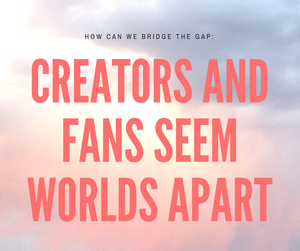The Origins of Fandom
- moommbanks
- Feb 28, 2018
- 3 min read

By definition, the word "fandom" describes all people who identify as fans of a particular subject. For this project, "fandom" will encompass groups or networks of people who interact with each other via fan art, role play, fan fiction, or forum chat rooms centered around a book, movie, television show, or other pop culture subject.
How Fandom Got Started
The origins of Fandom go way back. People have always wanted to play an active part in showing their love for other people's creative work. The evidence that I was able to find can be traced back to Ancient Greece, actually.
A good example of what is meant by "fandom culture" can be seen in the writings of philosophers arguing about the relationship between the hero Achilles and his closest companion and fellow warrior Patroclos. That is, writers and scholars like Aeschylus and Plato wrote publicly about whether or not they thought the two warriors were involved in a sexual relationship. According to Celsiana Warwick at UC Davis, these debates were heated and often involved one scholar outright insulting the other when their opinions differed.
That being said, modern fandom culture didn't really develop until the 1960s, with the advent of widely accessible public television. While not the first instance of a highly involved and active fandom base, Star Trek is perhaps the most well-known example of modern fandom in action.
Star Trek first aired in 1966 and immediately garnered a fanbase composed primarily of young women, thanks to its inclusive cast, progressive ideology, and interesting storylines. While the original series totaled only three seasons - a short run by today's standards - the steady determination of its fans have resulted in a broad franchise that now includes seven series and fourteen movies.
Fanning the Flame
The most important thing that fandom requires is, well, interaction with other fans. The networking between enthusiasts that is now common began in the 1930s when the first "fanzines" or fan magazines were created and distributed among fans of popular comic series "The Comet."
Again, during the run of the original Star Trek series, fanzines were instrumental in creating mailing lists of people who wanted more from creators. These fanzines included art, essays, and analysis as well as creative works. In fact, Gene Roddenberry - creator of Star Trek - was even known to consult popular fan writers about Star Trek lore. In fact, Roddenberry and other show creators felt that their fans were so important that they kept their fans updated by sending out personalized letters about the show. Some have become involved in the creation of later franchises.
With the advent of the internet in the 1990s, shows like The X-Files also hit the big time in terms of fandom. Prior to that decade, most fanzines were distributed physically and it was often difficult to get put on the mailing list for 'zines because there was some danger that creators would sue, or that sensitive (read: sexual) material within fanzines could get creators in trouble with then-stringent public decency laws. The internet changed all of that, however. Many 'zines became web-based, and communication between fans became much easier with the advent of chatrooms and forums. It also became much easier to conceal one's real-life identity, and thus avoid legal repercussions for being involved with fan dealings.










Comments